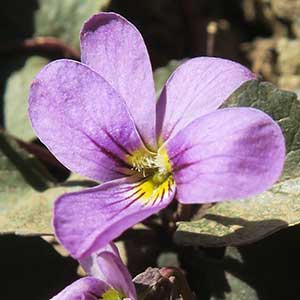Viola flettii
Viola hastata
Flett's violet, Olympic violet, rock violet
halberd-leaf or halberdleaf yellow violet, halberdleaf yellow violet
1–3, ascending to erect, mostly glabrous, on caudex from fleshy rhizome.
1(–2), erect, leafless proximally, leafy distally, glabrous or sparsely puberulent, from fleshy rhizome.
basal and cauline;
basal: 1–3;
stipules linear-lanceolate, margins entire or with glandular processes, apex acuminate;
petiole 1.5–9.7 cm, mostly glabrous;
blade purple-tinted and –veined, broadly reniform to ovate, 0.9–2.4 × 1.2–4 cm, base cordate, margins finely crenate-serrate, eciliate, apex acute to obtuse, surfaces glabrous or sparsely pubescent along veins adaxially;
cauline similar to basal except: stipules ovate to lanceolate, margins entire or shallowly laciniate;
petiole 0.7–5.9 cm, usually glabrous;
blade 0.8–2.1 × 1.2–3.1 cm.
basal and cauline;
basal: 0–1;
stipules ovate to lanceolate, margins laciniate with gland-tipped projections, apex usually acuminate;
petiole 3–11.5 cm, usually glabrous;
blade sometimes gray-green abaxially, usually mottled light green adaxially, widely or narrowly hastate to ovate, 2.5–4.4 × 1.8–3.2 cm, base hastate to cordate or truncate, margins serrate or crenate, ciliate or eciliate, apex acute, surfaces usually glabrous, sometimes scabrous;
cauline similar to basal except: leaves usually restricted to distal ends of naked stems;
petiole 1–2.5 cm;
blade 2–10 × 1.1–4.5 cm.
1.8–7.1 cm, usually glabrous.
1–5.3 cm, usually glabrous.
sepals lanceolate, margins eciliate, auricles 0.5–1.5 mm;
petals soft reddish violet on both surfaces, all with yellow area basally, lower 3 dark violet-veined, lateral 2 bearded, lowest with white around yellow area, 10–15 mm, spur yellow, gibbous, 0.5–2 mm;
style head bearded; cleistogamous flowers axillary.
sepals lanceolate to ovate, margins mostly eciliate, auricles 0.5–1 mm;
petals lemon-yellow usually on both surfaces, lower 3 and sometimes upper 2 brownish purple-veined, lateral 2 bearded, lowest 9.5–12 mm, spur yellow to greenish, gibbous, 0.5–2 mm;
style head bearded; cleistogamous flowers axillary.
± spherical, 5–9 mm, glabrous.
ovoid to ellipsoid, 6–8 mm, glabrous.
dark brown to brownish purple, 2.5–3 mm.
beige to bronze, 2–2.5 mm.
= 12.
Viola flettii
Viola hastata
Viola flettii is endemic to the Olympic Mountains of northwestern Washington. C. S. McCreary (2005) noted that although morphologically and ecologically distinct, V. cuneata, V. flettii, and V. ocellata are closely related.
(Discussion copyrighted by Flora of North America; reprinted with permission.)
V. B. Baird (1942) commented that Viola hastata is more closely related to V. glabella than to any eastern species.
(Discussion copyrighted by Flora of North America; reprinted with permission.)


